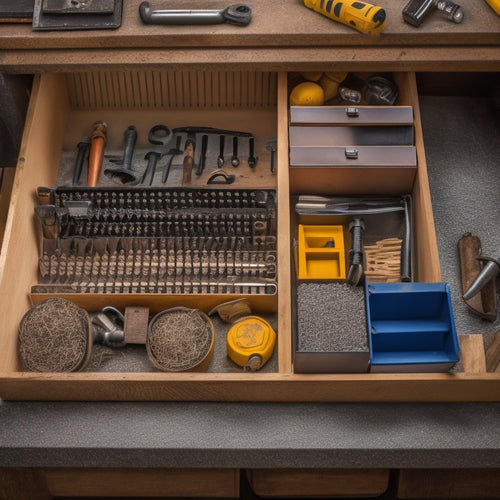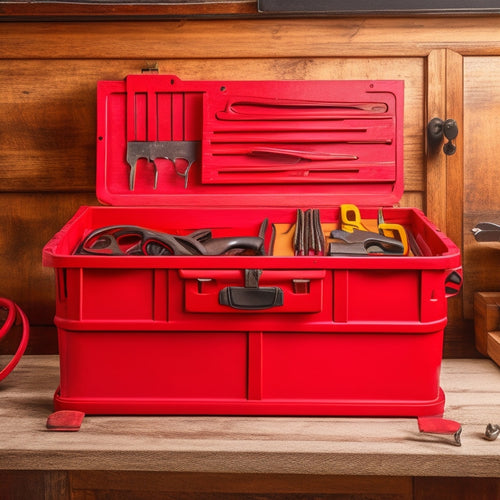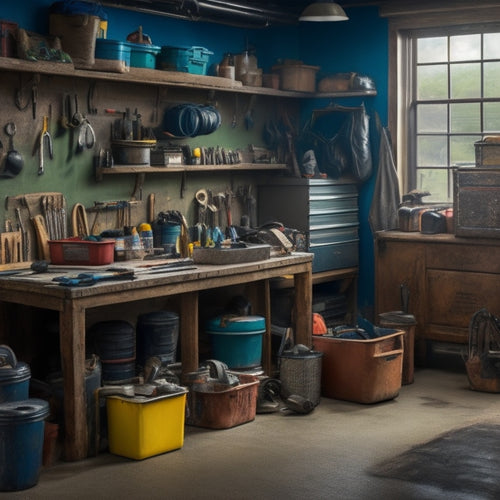
Benefits of a Rolling Tool in Construction
Share
By integrating a rolling tool into your construction workflow, you can immediately experience a significant enhancement in productivity, efficiency, and cost savings. You'll streamline task planning, reduce tool-related downtime, and promote team collaboration, all while increasing productivity and efficiency. You'll also minimize labor costs, optimize tool storage, and improve job site accessibility and safety. Additionally, you'll enjoy greater flexibility in workflow, reduced risk of tool damage, and simplified tool inventory management, all of which contribute to a more cost-effective and efficient project. And that's just the beginning - you'll uncover even more advantages as you investigate the benefits of rolling tools further.
Key Takeaways
- A rolling tool in construction increases productivity and efficiency by streamlining tasks, reducing clutter, and minimizing accident risks.
- It promotes cost savings and labor efficiency by reducing tool loss and replacement costs, and enhancing workflow design.
- A rolling tool enhances organization and inventory management by optimizing tool storage, reducing risk of loss, and improving tool tracking.
- It improves job site accessibility and safety by providing effortless transport of heavy loads, reducing site congestion, and promoting safety protocols.
- A rolling tool boosts employee morale and collaboration by reducing fatigue, encouraging a positive work environment, and demonstrating investment in employee well-being.
Increased Productivity on Site
Step up your construction game by streamlining tasks with a rolling tool, and watch your productivity on site soar. By having all the necessary tools organized and within reach, you'll save time and reduce the likelihood of accidents caused by cluttered workspaces.
Effective time management is key to meeting project deadlines, and a rolling tool helps you stay on track by minimizing tool-related downtime.
Moreover, a rolling tool encourages team collaboration by providing a centralized hub for tool storage and transportation. This promotes crew members to work together more efficiently, as they can quickly access the tools they need without interrupting their colleagues.
With a rolling tool, you can assign tasks more effectively, ensuring that each team member has the right tools to complete their tasks on time. By streamlining your workflow and promoting teamwork, you'll see a significant increase in productivity, allowing you to complete projects faster and safer.
Reduced Labor Costs Savings
You'll find that a rolling tool in construction helps you achieve efficient workflow design, streamlining tasks and reducing bottlenecks.
This, in turn, allows you to optimize man-hour allocation, assigning labor resources where they're needed most.
Efficient Workflow Design
By optimizing workflow design, construction teams can considerably reduce labor costs and allocate resources more efficiently. You can achieve this by implementing workflow optimization techniques that streamline tasks, eliminate redundancy, and enhance productivity.
Collaborative planning strategies can also help identify potential bottlenecks and areas for improvement. By involving all stakeholders in the planning process, you can guarantee that everyone is on the same page, working towards a common goal.
A well-designed workflow can help you allocate resources more effectively, reducing labor costs and minimizing downtime.
With a rolling tool, you can easily move equipment and materials around the site, reducing the need for manual labor and increasing efficiency. By analyzing your workflow, you can identify areas where a rolling tool can make the most impact, and optimize its use to maximize productivity.
Reduced Man-Hour Allocation
How much time and money are wasted on manual labor when it could be allocated more efficiently? By implementing a rolling tool in your construction project, you can considerably reduce man-hour allocation and optimize your labor costs. This results in substantial savings, which can be reinvested in other areas of your project.
Here are some benefits of reduced man-hour allocation:
-
Increased time efficiency: With automated tools, you can complete tasks faster, freeing up your team to focus on higher-value tasks.
-
Improved task optimization: A rolling tool helps you identify and eliminate unnecessary tasks, streamlining your workflow and reducing labor hours.
-
Enhanced productivity: By reducing manual labor, you can redirect your team's energy towards more critical tasks, leading to increased productivity and better results.
-
Better resource allocation: With reduced labor hours, you can reallocate resources to other areas of your project, such as equipment maintenance or training.
-
Reduced labor costs: The most considerable benefit of all – reduced labor costs, which can add up to substantial savings over the course of your project.
Easier Tool Transportation Methods
Many construction projects involve a multitude of tools, equipment, and materials, often scattered across large job sites. As you traverse these sites, you know how essential it's to transport your tools efficiently. A rolling tool box is a transformative element in this regard. Its lightweight design and ergonomic handles make it easy to handle, reducing the strain on your back and shoulders.
Compact storage allows you to fit more tools in a smaller space, making it ideal for job sites with limited room. Durable materials guarantee your tools are protected from the elements, and multi-functional features like portable charging stations keep your devices powered up.
The rolling tool box's easy maneuverability and weather resistance make it perfect for crossing rough terrain and inclement weather. With a rolling tool box, you can focus on getting the job done rather than wasting time and energy transporting your tools.
It's a cost-effective solution that streamlines your workflow, making you more productive and efficient. The user-friendly interface guarantees you can quickly find what you need, saving you time and reducing frustration.
Better Organization of Equipment
You've streamlined your tool transportation with a rolling tool box. Now it's time to tackle the often-daunting task of organizing your equipment. A well-organized workspace is essential for efficiency, safety, and productivity.
With a rolling tool, you can optimize your tool storage, guaranteeing that every item has a designated place. This leads to better equipment tracking, allowing you to quickly identify what's in stock and what needs to be restocked.
Here are some benefits of better organization:
-
Inventory control: Easily track and manage your tools and equipment, reducing the risk of loss or misplacement.
-
Space optimization: Maximize your workspace by assigning a specific place for each tool, reducing clutter and increasing accessibility.
-
Maintenance scheduling: Schedule regular maintenance for your tools, ensuring they remain in good condition and prolonging their lifespan.
-
Tool customization: Tailor your tool arrangement to fit your specific needs, making it easier to find what you need when you need it.
-
Improved safety compliance: A well-organized workspace reduces the risk of accidents and guarantees that safety protocols are followed.
Improved Job Site Accessibility
Maneuvering a construction site can be a logistical nightmare, especially when dealing with heavy equipment and tight deadlines. You need to traverse through narrow aisles, avoid obstacles, and guarantee your team has quick access to the tools they need.
A rolling tool chest can greatly enhance site maneuvering by allowing you to move your equipment effortlessly around the site. With a rolling tool, you can easily transport heavy loads, reducing the risk of accidents and injuries caused by manual handling.
This improved tool accessibility also enables your team to work more efficiently, as they can quickly access the tools they need without having to search for them or waste time walking back and forth to a central storage area.
A rolling tool chest also helps to reduce congestion on the site, making it easier for you and your team to move around safely. By improving site maneuvering and tool accessibility, a rolling tool chest can help you complete projects faster, safer, and more efficiently.
Enhanced Tool Security Measures
You'll appreciate the enhanced tool security measures that come with a rolling tool in construction, particularly when it comes to locked compartments that safeguard your precious equipment.
By implementing access control systems, you'll be able to track who's using what tools and when, reducing the risk of theft and unauthorized use.
With reduced misplacement risks, you'll also save time and money that would've been spent searching for or replacing lost tools.
Locked Compartments Matter
Within the rugged confines of a construction site, your tools are constantly at risk of being lost, stolen, or damaged, which is why locked compartments matter in a rolling tool. A well-designed locked compartment guarantees tool safety by preventing unauthorized access and minimizing the risk of damage.
It's crucial to evaluate compartment design, accessibility features, and locking mechanisms when selecting a rolling tool.
Some key benefits of locked compartments include:
- Enhanced tool security through strong locking mechanisms
- Improved organization strategies for efficient tool retrieval
- Damage prevention through protective compartment liners
- User training and maintenance schedules to guarantee proper compartment use
- Ergonomic considerations for reduced fatigue and increased productivity
Access Control Systems
Advanced rolling tools often integrate access control systems, elevating tool security to the next level. As you consider implementing these systems, you'll appreciate the enhanced security features they provide.
Access technology, such as biometric controls, guarantees only authorized users can access the tool. System integration with existing infrastructure enables seamless user authentication and data reporting. With remote monitoring, you can track tool usage and receive alerts in real-time, allowing for swift response to potential security breaches.
Network connectivity enables you to manage access control systems from a central location, making it easier to manage multiple tools across various sites. Scalability options allow you to adapt the system to your growing needs.
Additionally, maintenance protocols guarantee the system remains up-to-date and compliant with industry standards. By meeting compliance standards, you can rest easy that your tool security measures align with regulatory requirements.
With an access control system, you can focus on your construction projects, knowing your tools are secure and your data is protected.
Reduced Misplacement Risks
Three out of every five construction projects experience tool misplacement or loss, resulting in considerable delays and financial losses.
You're likely no stranger to the frustration and financial burden that comes with losing essential tools on the job site.
Implementing a rolling tool in your construction project can considerably reduce misplacement risks.
This mobile storage solution enables you to keep track of your tools and equipment more efficiently.
With a rolling tool, you can:
- Improve tool tracking and inventory accuracy
- Reduce the time spent searching for lost tools
- Minimize the likelihood of tool theft
- Enhance accountability among team members
- Streamline tool organization and storage
Greater Flexibility in Workflow
Streamline your construction workflow by leveraging the versatility of a rolling tool. With a rolling tool, you can easily move your tools and equipment to where they're needed, allowing you to adapt to changing project requirements and prioritize tasks more efficiently. This flexibility is especially vital in construction, where unexpected delays or changes can occur at any moment.
| Workflow Stage | Traditional Tool Storage | Rolling Tool |
|---|---|---|
| Task Planning | Tools scattered across site | Tools organized, easily accessible |
| Task Execution | Frequent tool retrieval trips | Tools readily available, reducing downtime |
| Task Adjustment | Tools rearranged, reorganized | Tools easily relocated, reconfigured |
| Quality Control | Tools scattered, harder to inspect | Tools organized, easier to inspect |
| Cleanup | Tools scattered, harder to collect | Tools organized, easier to collect |
Reduced Risk of Tool Damage
As you employ a rolling tool in your construction workflow, you'll greatly reduce the risk of tool damage.
This is because the rolling design prevents rough handling, which can lead to scratches, dents, or even breakage.
Prevents Rough Handling
Your tools are a considerable investment, and rough handling can greatly shorten their lifespan. As a construction professional, you understand the importance of tool handling and the impact it has on the overall efficiency of your projects. By using a rolling tool, you can prevent rough handling and guarantee your tools are protected from damage.
Here are some benefits of using a rolling tool to prevent rough handling:
-
Improved tool handling: A rolling tool allows you to transport your tools safely, reducing the risk of drops and bumps that can cause damage.
-
Enhanced safety protocols: By incorporating a rolling tool into your workflow, you can establish best practices for equipment care and maintenance, reducing the risk of accidents and injuries.
-
Increased user awareness: A rolling tool promotes user awareness of the importance of proper tool handling, encouraging your team to take satisfaction in their work and handle tools with care.
-
Regular maintenance routines: With a rolling tool, you can establish regular maintenance routines to guarantee your tools are in top condition, extending their lifespan and reducing downtime.
-
Ergonomic design: A rolling tool is designed with ergonomics in mind, reducing strain on your body and promoting comfortable transportation of your tools.
Shields From Impact
You've invested significant time and resources in selecting the right tools for your construction projects, and it's equally important to protect them from impact damage. A rolling tool provides a shield against impact, reducing the risk of tool damage and subsequent downtime.
With its sturdy design and impact-resistant materials, a rolling tool can withstand accidental drops and bumps, ensuring your tools remain functional and ready for use.
The protective features of a rolling tool are designed to absorb and distribute impact forces, minimizing the risk of damage to your tools. This impact resistance is critical in construction environments where accidents can happen quickly.
By shielding your tools from impact, you can prevent costly repairs, reduce replacement costs, and maintain productivity. With a rolling tool, you can have confidence that your tools are protected, and your project timelines remain on track.
Simplified Tool Inventory Management
Within the confines of a construction site, tool inventory management can quickly spiral out of control, with misplaced or lost tools leading to costly delays and decreased productivity. You know how frustrating it's when you can't find the right tool when you need it.
A rolling tool chest solves this problem by providing a centralized and organized storage system for all your tools and equipment. This means you can:
- Keep track of your tools with ease, thanks to inventory tracking features
- Guarantee tool accessibility, reducing the time spent searching for misplaced items
- Reduce tool loss and theft, saving you money in replacement costs
- Keep your tools organized and protected from damage
- Easily transport tools and equipment to where they're needed on site
With a rolling tool chest, you'll be able to focus on getting the job done, rather than wasting time searching for lost tools.
Boosted Employee Morale Levels
On a construction site, where physical labor and mental focus are constantly demanded, a rolling tool chest can have a significant impact on employee morale levels.
You're well aware that a happy worker is a productive worker, and a rolling tool chest can play a key role in enhancing morale.
With a rolling tool chest, you'll experience reduced fatigue and strain, as you won't have to constantly search for or carry tools around the site. This reduction in physical demands can lead to a significant increase in job satisfaction, which in turn, elevates morale.
Additionally, a rolling tool chest promotes team bonding by allowing workers to collaborate more efficiently, as they can easily access the tools they need without interrupting their colleagues.
Positive reinforcement is also a key benefit, as a rolling tool chest shows your employees that you're invested in their well-being and willing to provide them with the tools they need to succeed.
Frequently Asked Questions
Can a Rolling Tool Chest Be Customized for Specific Construction Tasks?
You can customize a rolling tool chest to fit specific construction tasks by exploring various customization options, such as task-specific features like dividers, trays, and organizers, to create a personalized solution that enhances your workflow and prioritizes on-site safety.
Are Rolling Tool Chests Suitable for Use on Uneven or Rough Terrain?
As you venture into uncharted territories, you'll find that rolling tool chests with advanced mobility features and terrain adaptability are your trusted companions, maneuvering rough terrain with ease, ensuring your tools and you remain safe and productive.
Can a Rolling Tool Chest Be Locked to Prevent Unauthorized Access?
You'll find that many rolling tool chests come equipped with sturdy security features, such as reinforced locks and anchor points, allowing you to securely lock your tools and prevent theft, giving you peace of mind on the job site.
How Much Weight Can a Typical Rolling Tool Chest Safely Support?
You'll want to check the manufacturer's specs, but typically, a rolling tool chest can safely support a weight capacity of 500-1000 pounds, depending on the model, ensuring your tool organization remains stable and secure.
Are Rolling Tool Chests Compatible With Standard Construction Site Power Outlets?
You'll find that most rolling tool chests are designed with power outlet compatibility in mind, featuring built-in outlets or cord organizers that guarantee safe and convenient access to power, meeting standard construction site outlet requirements.
Conclusion
By incorporating a rolling tool into your construction workflow, you'll experience a significant enhancement in efficiency and productivity. For instance, a recent study found that a construction company in California reduced their tool setup time by 30% and increased their daily output by 25% after implementing a rolling tool system. With a rolling tool, you'll be able to tackle projects faster, reduce costs, and simplify your workflow, ultimately leading to increased profitability and success.
Related Posts
-

Best Screw Storage Bins for Organizing Your Toolbox
You need a reliable screw storage system to maximize your productivity and efficiency, and that's exactly what the ri...
-

Portable Tool Chest Essentials
When stocking your portable tool chest, you'll want to prioritize essential hand tools like hammers, tape measures, a...
-

Best Cheap Tool Boxes for Budget-Conscious Buyers
You need a reliable tool box that gets the job done without breaking the bank. Look for durable materials, rust-resis...


